Monitoring Selected National HIV Prevention and Care Objectives By Using HIV Surveillance Data United States and 6 Dependent Areas, 2019: Special Focus Profiles


The Special Focus Profiles highlight the distribution of the diagnosis-based HIV care outcomes and identify potential gaps in these outcomes among 6 populations of interest to HIV prevention programs in state and local health departments: (1) Gay, Bisexual, and Other Men Who Have Sex With Men (MSM), (2) Persons Who Inject Drugs (PWID), (3) Transgender Persons, (4) Women, (5) Persons With Perinatally Acquired HIV Infection, and (6) Young Persons [aged 13–24 years].
Gay, Bisexual, and Other Men Who Have Sex with Men
Gay, bisexual, and other men who have sexual contact with men (MSM) are most affected by HIV in the United States. Stigma, homophobia, and discrimination make MSM of all races/ethnicities susceptible to multiple physical and mental health problems and can affect whether they seek and receive high-quality health services, including HIV testing, treatment, and other prevention services. In 2019, MSM accounted for 65.4% (24,084 MMSC not including persons with infection attributed to MMSC-IDU) of the 36,801 HIV diagnoses in the United States and 6 dependent areas. Many Black/African American and Hispanic/Latino MSM with HIV, particularly young MSM, are unaware of their HIV infection. Lack of awareness of HIV status among young MSM may be due to recent infection, not getting tested due to underestimation of personal risk or stigma (e.g. homophobia), or fewer opportunities to get tested. Persons who do not know they have HIV do not get medical care or receive treatment and can unknowingly infect others.
Among MSM with diagnosed HIV infection in 2019 in 45 jurisdictions with complete laboratory reporting, stage of disease at diagnosis varied with 66.5% of infections diagnosed at an earlier stage (stage 0, 1 or 2) and 18.7% classified as stage 3 (AIDS) at the time of diagnosis (Table 1a). Moreover, 82.1% of MSM were linked to HIV medical care within 1 month of diagnosis and 69.8% were virally suppressed within 6 months of diagnosis (Table 2a). Of 528,606 persons with infection attributed to MMSC living with diagnosed HIV in the 45 jurisdictions at year-end 2019, 77.7% received HIV medical care, 58.6% were retained in HIV medical care, and 68.1% were virally suppressed at the most recent viral load test (Tables 3a and 4a).
- Gay, Bisexual, and Other Men Who Have Sex with Men
- Persons Who Inject Drugs
- Transgender Persons and Persons of Additional Gender Identity
- Women
- Perinatally acquired HIV infection
- Perinatally acquired HIV infection
- Young Persons
- 2019 Status & Disparities in Linkage to Care Within 1 Month of HIV Diagnosis and Viral Suppression
- 2019 Status & Disparities in Linkage to HIV Medical Care Within 1 Month of HIV Diagnosis
- 2019 Status & Disparities in Viral Suppression
HIV care outcomes varied among MSM by race/ethnicity. For MSM of all racial/ethnic groups, ≥63.2% of infections were diagnosed at an earlier stage (Table 1c, Figure 28). Yet, Asian (23.4%), White (21.1%), and Hispanic or Latino MSM (19.7%) had ≥20% of infections classified as stage 3 (AIDS) at the time of diagnosis. Among Asian, White, and Hispanic or Latino MSM, infections classified as stage 3 (AIDS) increased with age at the time of diagnosis (Table 1d).
Figure 28. Earlier and Late Stage of Disease at HIV Diagnosis during 2019, among Men Who Have Sex with Men, by Race/Ethnicity—44 States and the District of Columbia
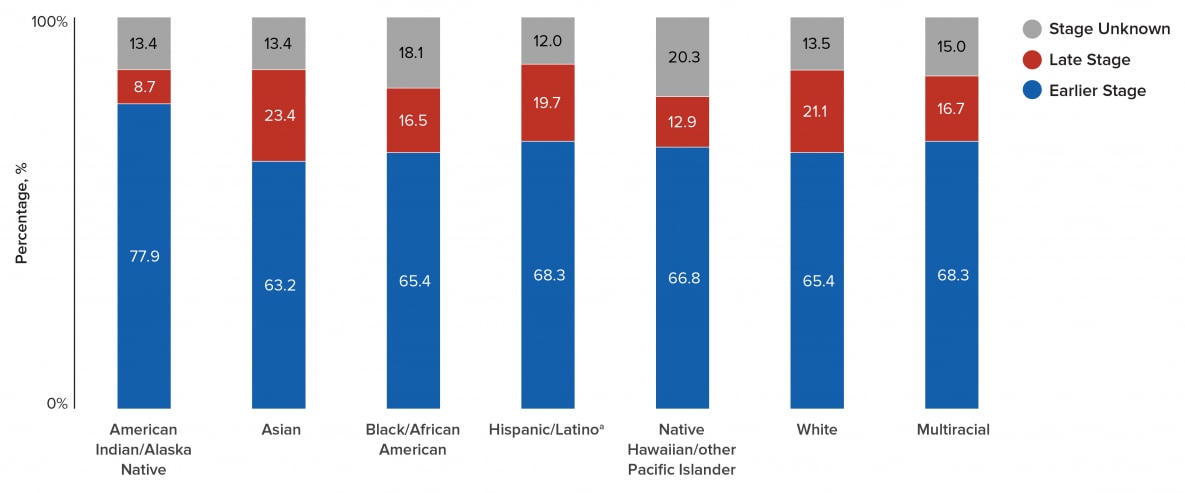
Note. See Guide on Acronyms and Initialisms, Data Tables, and Technical Notes for more information on Definitions and Data Specifications.
aHispanic/Latino persons can be of any race.
The highest percentage for MSM by race/ethnicity who were linked to care within 1 month of diagnosis was for American Indian or Alaska Native persons (85.6%) and the lowest percentage linked to care within 1 month of diagnosis was for Black or African American persons (78.2%) (Table 2c, Figure 29). Among Black/African American MSM, persons aged 13–34 years had the lowest percentages linked to care within 1 month of diagnosis (13–24 years: 77.4%, 25–34 years: 77.5%; Table 2d). The highest percentage for MSM by race/ethnicity who were virally suppressed within 6 months of diagnosis was for Asian persons (77.0) and the lowest percentage for viral suppression within 6 months of diagnosis was for Black or African American persons (65.0) (Table 2c, Figure 29). Among Black or African American MSM, persons aged 25–34 years and persons aged ≥55 years had the lowest percentages for viral suppression within 6 months of diagnosis (25–34 years: 63.8%, ≥55 years: 63.7%; Table 2d).
Figure 29. Linkage to HIV Medical Care and Viral Suppression within 6 Months of HIV Diagnosis during 2019, among Men Who Have Sex with Men, by Race/Ethnicity—44 States and the District of Columbia
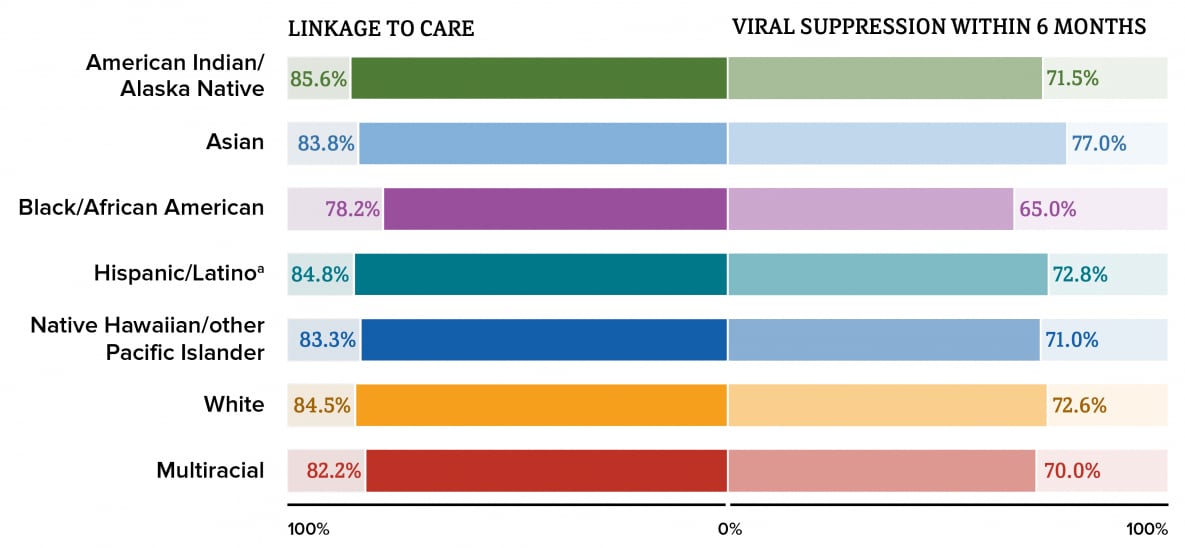
Note. See Guide on Acronyms and Initialisms, Data Tables, and Technical Notes for more information on Definitions and Data Specifications.
aHispanic/Latino persons can be of any race.
The highest percentage for MSM by race/ethnicity who received any HIV medical care was for multiracial persons (86.2%) and the lowest percentage was for Native Hawaiian or other Pacific Islander persons (73.8%) (Table 3c, Figure 30). Among Native Hawaiian or other Pacific Islander MSM, persons aged 13–24 years had the lowest percentage who received any HIV medical care (68.0%) (Table 3d). The highest percentage for MSM by race/ethnicity who were retained in HIV medical care was for multiracial persons (65.0%) and the lowest percentage was for Native Hawaiian or other Pacific Islander persons (52.2%). Among Native Hawaiian or other Pacific Islander MSM, persons aged 35–44 years had the lowest percentage retained in HIV medical care (47.5%) (Table 3d). The highest percentage for MSM by race/ethnicity who were virally suppressed at the most recent viral load test was for multiracial persons (74.5%) and the lowest percentage was for Black or African American persons (61.6%) (Table 3c, Figure 30). Among Black or African American MSM, persons aged 25–34 years had the lowest percentage for viral suppression (59.6%) (Table 3d).
Figure 30. Receipt of HIV Medical Care, Retention in HIV Medical Care, and Viral Suppression during 2019, among Men Who Have Sex with Men, by Race/Ethnicity—44 States and the District of Columbia
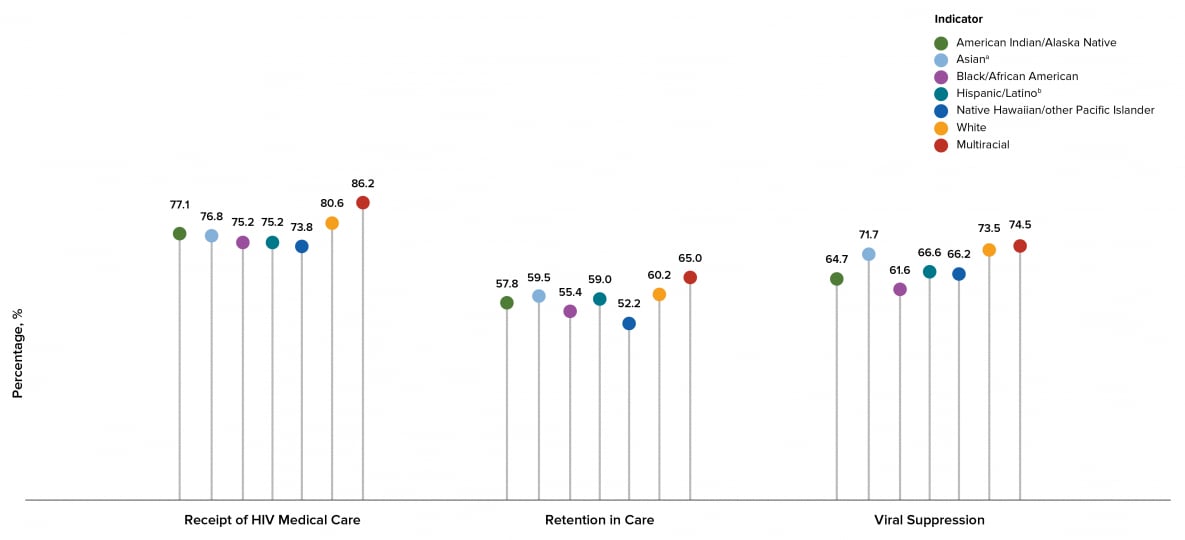
Note. See Guide to Acronyms and Initialisms, Data Tables, and Technical Notes for more information on definitions and data specifications.
aIncludes Asian/Pacific Islander legacy cases.
bHispanic/Latino persons can be of any race.
Persons Who Inject Drugs
Persons who inject drugs (PWID) can get HIV if they use and share needles, syringes, or other drug injection equipment (e.g., cookers) that someone with HIV has used. PWID account for about 1 in 15 HIV diagnoses in the United States. In recent years, the opioid (including prescription and synthetic opioids) and heroin crisis has led to increased numbers of PWID. HIV diagnoses among PWID have increased in the 50 states and District of Columbia. IDU in rural areas has created prevention challenges and placed new populations at risk for HIV.
Among PWID with diagnosed HIV infection in 2019 in 45 jurisdictions with complete laboratory reporting, stage of disease at diagnosis varied by selected characteristics. Overall, 58.2% of infections were diagnosed at an earlier stage (stage 0, 1 or 2) and 22.0% were classified as stage 3 (AIDS) at the time of diagnosis (Table 1a). Moreover, the percentage of PWID linked to care within 1 month of diagnosis was 75.4% and 54.6% were virally suppressed within 6 months of diagnosis (Table 2a). Of 98,290 persons with infection attributed to injection drug use living with diagnosed HIV in the 45 jurisdictions at year-end 2019, 68.0% received HIV medical care, 52.9% were retained in HIV medical care, and 56.9% were virally suppressed at their most recent viral load test (Tables 3a and 4a).
HIV care outcomes varied among PWID by sex at birth and race/ethnicity. Among persons with infection attributed to IDU by race/ethnicity, American Indian or Alaska Native males (70.8%) and White females (65.7%) had the highest percentages for persons who were diagnosed at an earlier stage and Asian males (39.5%) and Black or African American females (54.0%) had the lowest percentages for persons who were diagnosed at an earlier stage at time of diagnosis (Figure 31). Among males with infection attributed to IDU by race/ethnicity, all racial/ethnic groups (except American Indian or Alaska Native and Native Hawaiian or other Pacific Islander persons) had over 20% of infections classified as stage 3 (AIDS) at time of diagnosis. Among females with infection attributed to IDU by race/ethnicity, Asian, Black or African American, and Hispanic or Latino persons had over 20% of infections classified as stage 3 (AIDS) at time of diagnosis (Table 1c, Figure 31).
Figure 31. Earlier and Late Stage of Disease at HIV Diagnosis during 2019, among Persons Who Inject Drugs, by Sex at Birth and Race/Ethnicity—44 States and the District of Columbia
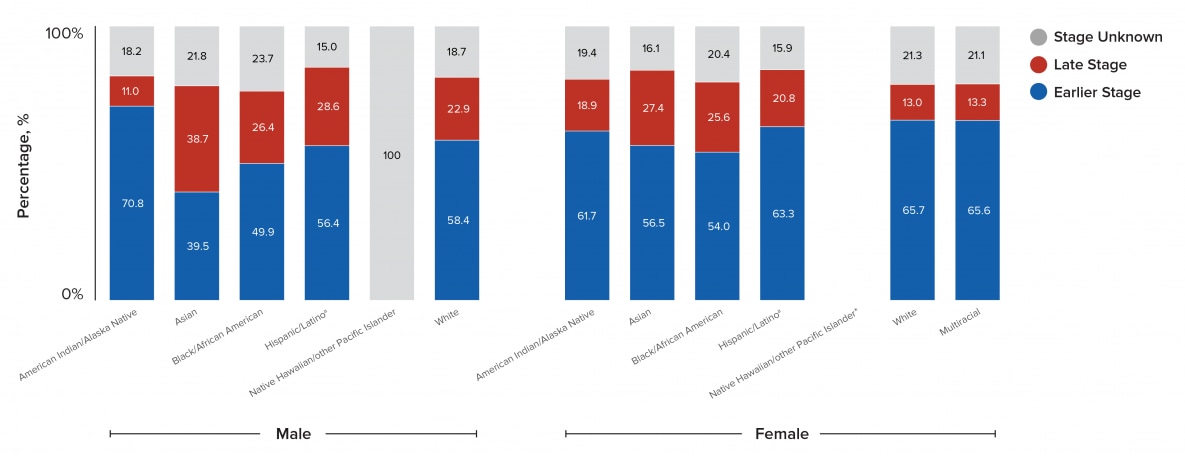
Note. See Guide on Acronyms and Initialisms, Data Tables, and Technical Notes for more information on Definitions and Data Specifications.
aHispanic/Latino persons can be of any race.
*No cases diagnosed among this group.
Among males with infection attributed to IDU by sex at birth and race/ethnicity, ≥73.7% were linked to care within 1 month of diagnosis and ≥41.0% were virally suppressed within 6 months of diagnosis in 2019. Among females with infection attributed to IDU by sex at birth and race/ethnicity, ≥67.7% were linked to care within 1 month of diagnosis and ≥40.6% were virally suppressed within 6 months of diagnosis in 2019 (Table 2c, Figure 32).
Figure 32. Linkage to HIV Medical Care and Viral Suppression within 6 Months of HIV Diagnosis during 2019, among Persons Who Inject Drugs, by Sex at Birth and Race/Ethnicity—44 States and the District

Note. See Guide on Acronyms and Initialisms, Data Tables, and Technical Notes for more information on Definitions and Data Specifications.
aHispanic/Latino persons can be of any race.
*No cases diagnosed among this group.
The highest percentage by sex at birth and race/ethnicity for PWID who received any HIV medical care was for multiracial persons (males: 86.3%, females: 88.0%) and the lowest percentages were for Hispanic or Latino males (58.9%) and Asian females (61.7%). The highest percentage by sex at birth and race/ethnicity for PWID who were retained in HIV medical care was for multiracial persons (males: 68.5%, females: 69.6%) and the lowest percentages were for Hispanic or Latino males (48.6%) and Asian females (48.5%). The highest percentage by sex at birth and race/ethnicity for PWID who were virally suppressed at the most recent viral load test was for multiracial persons (males: 72.0%, females: 71.5%) and the lowest percentages were for Hispanic or Latino males (49.8%) and Native Hawaiian or other Pacific Islander females (53.7%) (Table 3c, Figure 33).
Figure 33. Receipt of HIV Medical Care, Retention in HIV Medical Care, and Viral Suppression during 2019, among Persons Who Inject Drugs, by Sex at Birth and Race/Ethnicity—44 States and the District of Columbia
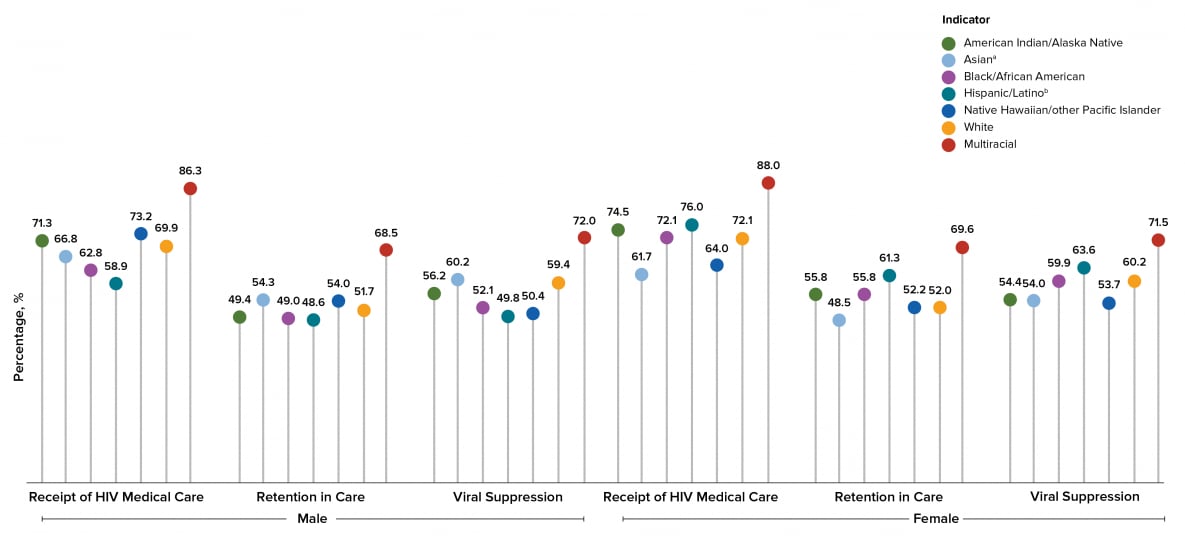
Note. See Guide on Acronyms and Initialisms, Data Tables, and Technical Notes for more information on Definitions and Data Specifications.
aIncludes Asian/Pacific Islander legacy cases.
bHispanic/Latino persons can be of any race.
Transgender Persons and Persons of Additional Gender Identity
Transgender is an umbrella term that is used to identify persons whose sex assigned at birth does not match current gender identity or expression. Gender identity refers to one’s internal understanding of one’s own gender, or the gender with which a person identifies. Gender expression is a term used to describe people’s outward presentation of their gender. Gender identity and sexual orientation are different facets of identity. Everyone has a gender identity and a sexual orientation, but a person’s gender does not determine a person’s sexual orientation. Transgender persons and persons of additional gender identity may identify as heterosexual, homosexual, bisexual, or none of the above. Transgender persons and persons of additional gender identity face numerous prevention challenges, including lack of public/provider knowledge about gender identity and transgender issues and social rejection and exclusion (e.g., transphobia or discrimination), and are underreported (e.g. gaps in reporting or limited data availability) or not well-represented in HIV prevention activities (e.g., PrEP and treatment interventions).
Among transgender persons and persons of additional gender identity with diagnosed HIV infection during 2019 in 45 jurisdictions with complete laboratory reporting, stage of disease at diagnosis varied by selected characteristics. Overall, 72.0% of infections were diagnosed at an earlier stage (stage 0, 1, or 2) and 13.6% were classified as stage 3 (AIDS) at the time of diagnosis (Table 1a). Moreover, 83.4% of transgender persons and persons of additional gender identity were linked to HIV medical care within 1 month of diagnosis and 67.2% were virally suppressed within 6 months of diagnosis in 2019 (Table 2a). Of 925,077 persons living with diagnosed HIV in the 45 jurisdictions with complete reporting of laboratory data at year-end 2019, 10,260 (1.1%) were transgender persons (Table 3a). Of 10,260 transgender persons and persons of additional gender identity living with diagnosed HIV, 84.6% received HIV medical care, 66.6% were retained in HIV medical care, and 67.2% were virally suppressed at their most recent viral load test (Tables 3a and 4a, Figure 34). Please use caution when interpreting data for transgender persons, persons of additional gender identity, and their subpopulations: the numbers are small.
Figure 34. Receipt of HIV Medical Care, Retention in HIV Medical care, and Viral Suppression during 2019, among Transgender Persons, 44 States and the District of Columbia
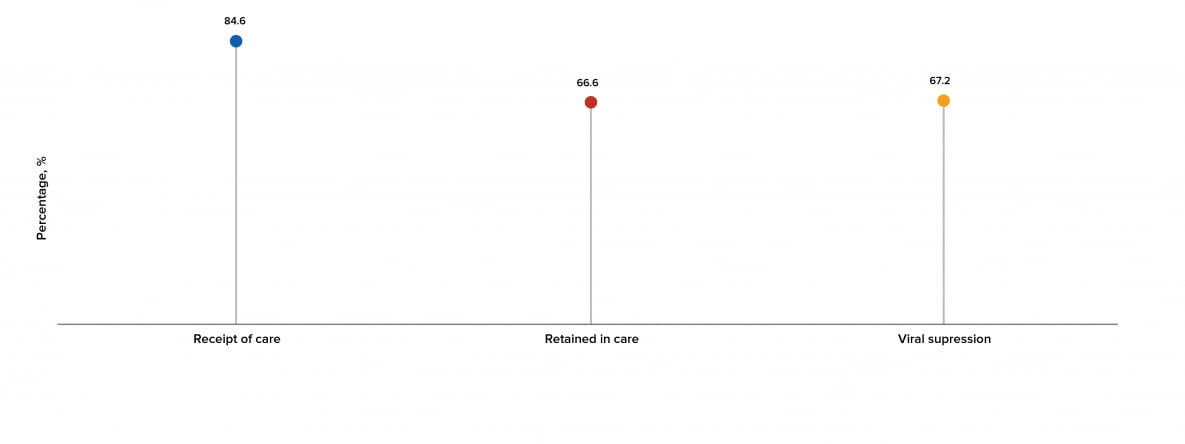
Note. See Guide to Acronyms and Initialisms, Data Tables, and Technical Notes for more information on definitions and data specifications.
Women
Though HIV diagnoses among women have declined in recent years, approximately 7,000 women received an HIV diagnosis in the United States and 6 dependent areas in 2019. One in nine women with HIV are unaware they have it. Because some women may be unaware of their partner’s risk factors for HIV (such as injection drug use or having sex with men), they may not use condoms or medicines to prevent HIV.
Among women with diagnosed HIV infection during 2019 in 45 jurisdictions with complete laboratory reporting, stage of disease at diagnosis varied by selected characteristics. Overall, 63.3% of infections were diagnosed at an earlier stage (stage 0, 1, or 2) and 20.5% were classified as stage 3 (AIDS) at the time of diagnosis (Table 1a). Moreover, 80.1% of women were linked to care within 1 month of diagnosis and 67.5% were virally suppressed within 6 months of diagnosis (Table 2a). Of 212,405 women living with diagnosed HIV in the 45 jurisdictions with complete reporting of laboratory data at year-end 2019, 75.8% received HIV medical care, 57.9% were retained in care, and 64.1% were virally suppressed at their most viral load recent test (Tables 3a and 4a).
HIV care outcomes varied among women by race/ethnicity. For women of all racial/ethnic groups with diagnosed HIV, ≥59.9% of infections were diagnosed at an earlier stage. Yet, Asian (22.8%), Hispanic or Latino (22.3%), Native Hawaiian or other Pacific Islander (22.2%), and Black or African American females (21.0%) had >20% of infections classified as stage 3 (AIDS) at the time of diagnosis (Table 1c, Figure 35).
Figure 35. Earlier and Late Stage of Disease at HIV Diagnosis during 2019, among Women, by Race/Ethnicity—44 States and the District of Columbia
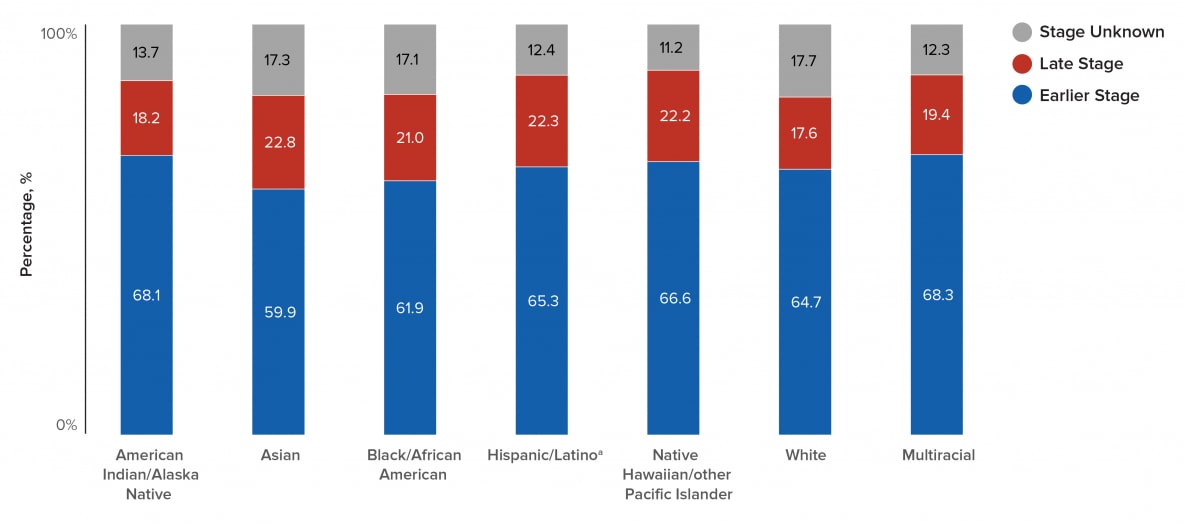
Note. See Guide on Acronyms and Initialisms, Data Tables, and Technical Notes for more information on Definitions and Data Specifications.
aHispanic/Latino persons can be of any race.
The highest percentage for women by race/ethnicity who were linked to HIV medical care within 1 month of diagnosis was for American Indian or Alaska Native persons (84.1%) and the lowest percentage was for White persons (77.5%). The highest percentage for women by race/ethnicity who were virally suppressed within 6 months of diagnosis was for Asian persons (75.0%) and the lowest percentage was for American Indian or Alaska Native females (52.3%) (Table 2c, Figure 36).
Figure 36. Linkage to HIV Medical Care and Viral Suppression within 6 Months of HIV Diagnosis during 2019, among Women, by Race/Ethnicity—44 States and the District of Columbia
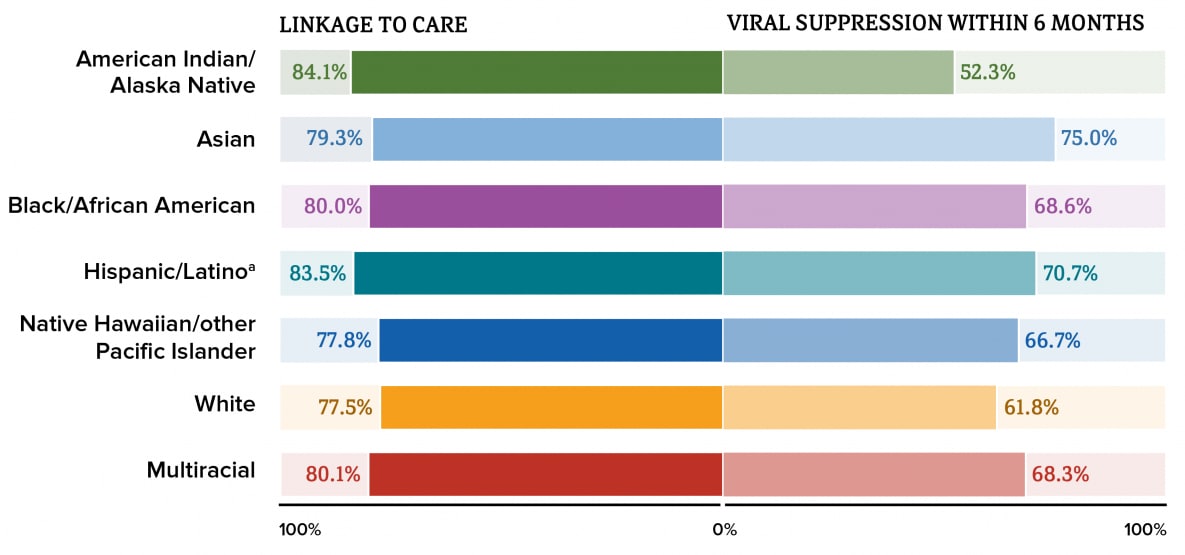
Note. See Guide on Acronyms and Initialisms, Data Tables, and Technical Notes for more information on Definitions and Data Specifications.
aHispanic/Latino persons can be of any race.
The highest percentage for women by race/ethnicity who received any HIV medical care was for multiracial persons (86.0%) and the lowest percentage was for Native Hawaiian or other Pacific Islander persons (70.4%) (Figure 37). The highest percentage for women by race/ethnicity who were retained in HIV medical care was for multiracial persons (66.3%) and the lowest percentage was for Native Hawaiian or other Pacific Islander persons (49.6%). The highest percentage for women by race/ethnicity who were virally suppressed at the most recent viral load test was for multiracial persons (71.3%) and the lowest percentage was for American Indian or Alaska Native persons (59.3%).
Figure 37. Receipt of HIV Medical Care, Retention in HIV Medical Care, and Viral Suppression during 2019, among Women, by Race/Ethnicity—44 States and the District of Columbia
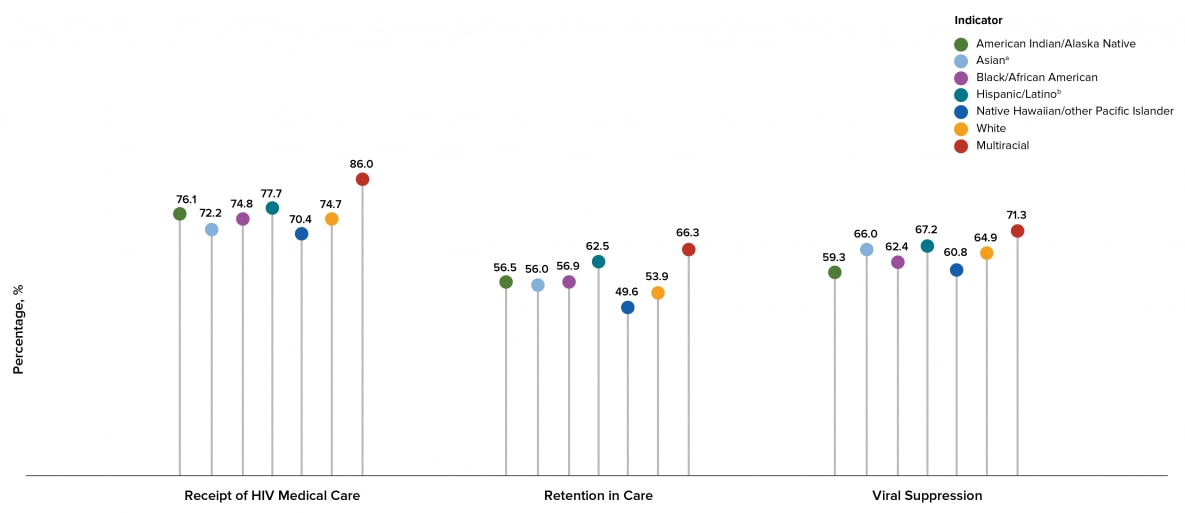
Note. See Guide on Acronyms and Initialisms, Data Tables, and Technical Notes for more information on Definitions and Data Specifications.
aIncludes Asian/Pacific Islander legacy cases.
bHispanic/Latino persons can be of any race.
Persons With Perinatally Acquired HIV Infection
In order to make informed decisions about antiretroviral therapy to reduce perinatal transmission of HIV to infants, pregnant women should know their HIV infection status. In 1995, the first recommendations for HIV counseling and voluntary testing for pregnant women were published. In 2006, CDC released revised recommendations for HIV testing which specified that opt-out HIV screening should be included in the routine panel of prenatal screening tests for all pregnant women. Because of delays in the reporting of births and diagnoses of HIV infection attributed to perinatal exposure, the data presented provide minimum counts reporting to the surveillance system. Please use caution when interpreting perinatally acquired HIV infection cases due to the dynamic nature of reporting. Additionally, numbers less than 12, and rates based on these numbers, should be interpreted with caution.
The overall annual rate of perinatally acquired HIV infections in the United States (regardless of place of birth) decreased from 1.6 per 100,000 live births in 2015 to 0.8 in 2019 (Table 10a). However, annual rates differed by race/ethnicity. Although the annual rate among Black or African American persons decreased from 6.8 in 2015 to 2.9 in 2019, the 2019 rate among Black or African American persons (2.9) was nearly 5 and 10 times the 2019 rates among Hispanic or Latino (0.6) and White persons (0.3) (Figure 38).
Figure 38. Perinatally Acquired HIV Infection, by Year of Birth and Mother’s Race/Ethnicity, 2015–2019—United States
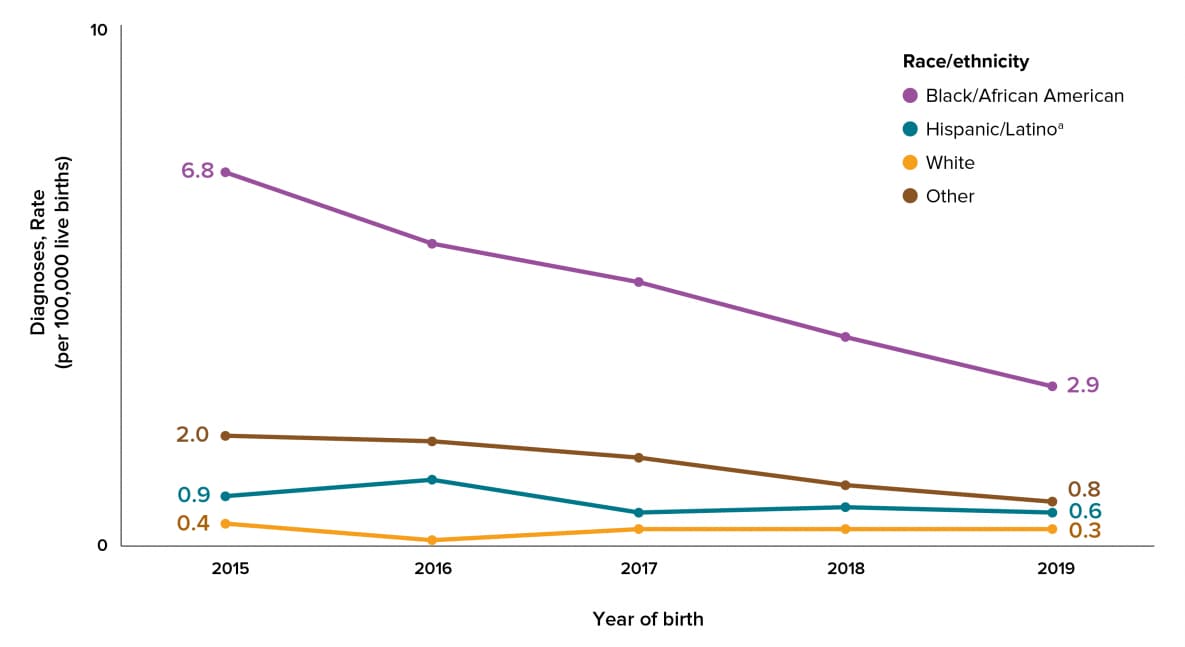
Note. See Guide on Acronyms and Initialisms, Data Tables, and Technical Notes for more information on Definitions and Data Specifications.
aHispanic/Latino persons can be of any race.
Among infants born in the United States, the overall annual rate of perinatally acquired HIV infections decreased from 1.4 per 100,000 live births in 2015 to 0.8 in 2019 (Table 10b). However, annual rates differed by race/ethnicity. Although the annual rate among Black or African American persons decreased from 5.8 in 2015 to 2.9 in 2019, the 2019 rate among Black or African American persons (2.9) was nearly 5 and 10 times the 2019 rates among Hispanic or Latino (0.6) and White persons (0.3) (Figure 39).
Figure 39. Perinatally Acquired HIV Infection among Persons Born in the United States, by Year of Birth and Mother’s Race/Ethnicity, 2015–2019—United States
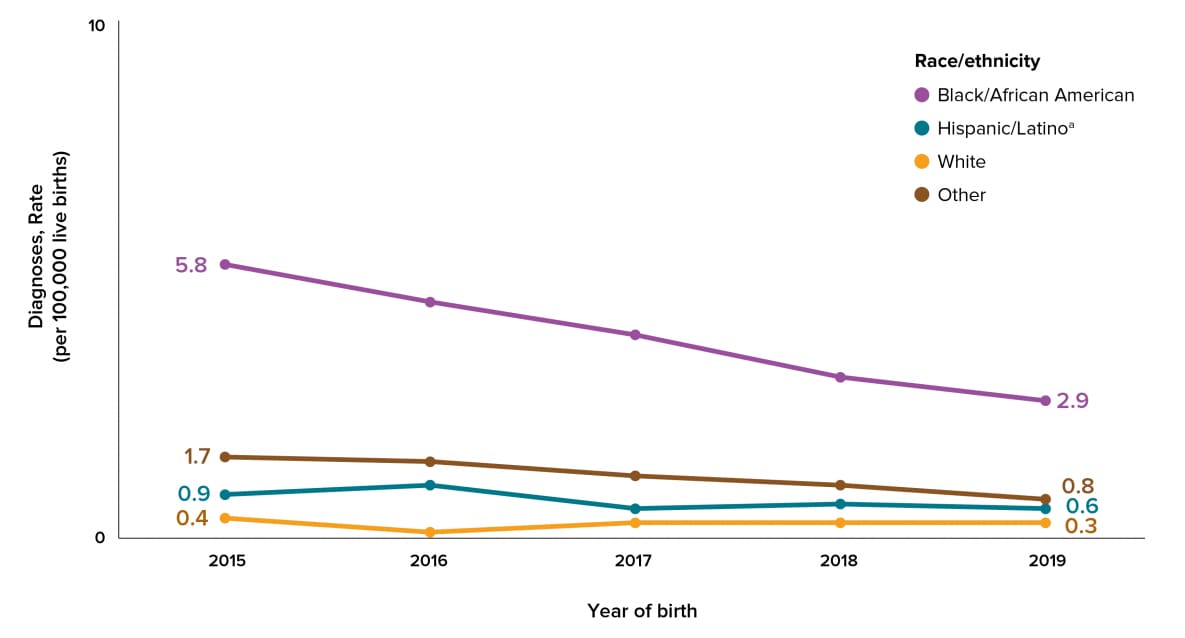
Note. See Guide on Acronyms and Initialisms, Data Tables, and Technical Notes for more information on Definitions and Data Specifications.
aHispanic/Latino persons can be of any race.
Young Persons
Young persons (persons aged 13–24 years) accounted for 20.8% of 36,801 diagnoses of HIV infection in 2019 in the United States and 6 dependent areas [1]. Young persons are the least likely of any age group to be aware of their HIV infection. Lack of awareness of HIV status may be due to recent infection or low rates of HIV testing. Persons who do not know they have HIV do not get medical care or receive treatment and can unknowingly infect others. In addition, young persons have higher rates of STDs and lower rates of condom use, greatly increasing the chance of getting or transmitting HIV. Addressing HIV among this group requires that they have access to the information and tools they need to make healthy decisions, reduce their risk, get treatment, and stay in care.
Among young persons with diagnosed HIV infection during 2019 in 45 jurisdictions with complete laboratory reporting, 75.2% of infections were diagnosed at an earlier stage (stage 0, 1 or 2) and 8.4% were classified as stage 3 (AIDS) at time of diagnosis (Table 1a). Moreover, 79.0% of young persons were linked to HIV medical care within 1 month of diagnosis and 68.2% were virally suppressed within 6 months of diagnosis (Table 2a). Of 29,533 young persons living with diagnosed HIV in the 45 jurisdictions at year-end 2019, 80.0% received HIV medical care, 58.7% were retained in HIV medical care, and 63.3% were virally suppressed at their most recent viral load test (Tables 3a and 4a).
Although HIV care outcomes varied among young persons by race/ethnicity, ≥72.1% of infections were diagnosed at an earlier stage for all racial/ethnic groups at time of diagnosis. Young Asian persons had the highest percentage of infections classified as stage 3 (AIDS) at time of diagnosis (11.7%), but no racial/ethnic group had >20% of infections classified as stage 3 (AIDS) at the time of diagnosis (Table 1c, Figure 40).
Figure 40. Earlier and Late Stage of Disease at HIV Diagnosis during 2019, among Young Persons, by Race/Ethnicity—44 States and the District of Columbia
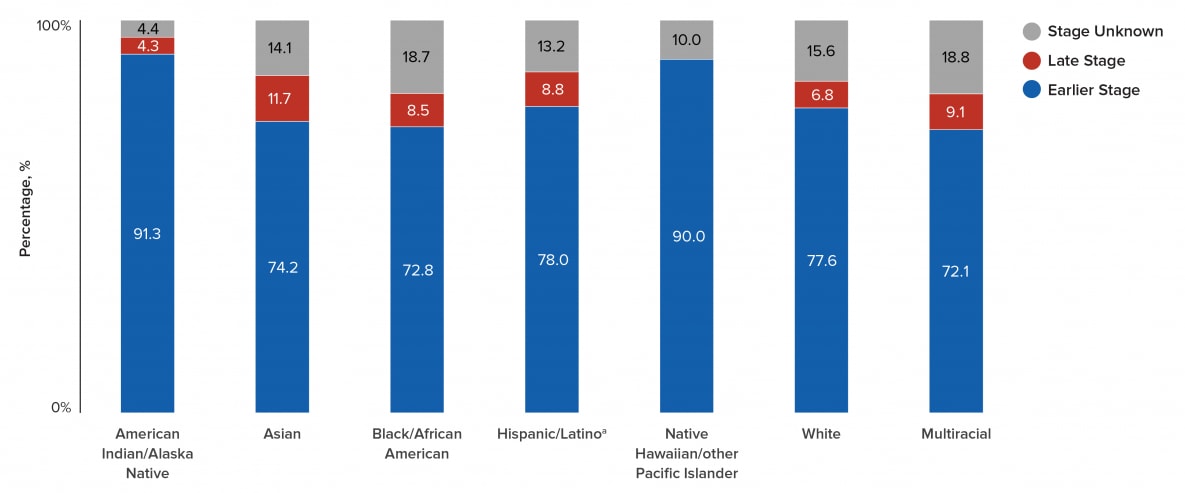
Note. See Guide on Acronyms and Initialisms, Data Tables, and Technical Notes for more information on Definitions and Data Specifications.
aHispanic/Latino persons can be of any race.
The highest percentage for young persons by race/ethnicity who were linked to HIV medical care within 1 month of diagnosis was for American Indian or Alaska Native persons (87.0%) and the lowest percentage was for Black or African American persons (77.1%). The highest percentage for young persons by race/ethnicity who were virally suppressed within 6 months of diagnosis was for Native Hawaiian or other Pacific Islander persons (80.0%) and the lowest percentage was for Black or African American persons (65.7%) (Table 2c, Figure 41).
Figure 41. Linkage to HIV Medical Care and Viral Suppression within 6 Months of HIV Diagnosis during 2019, among Young Persons, by Race/Ethnicity—44 States and the District of Columbia
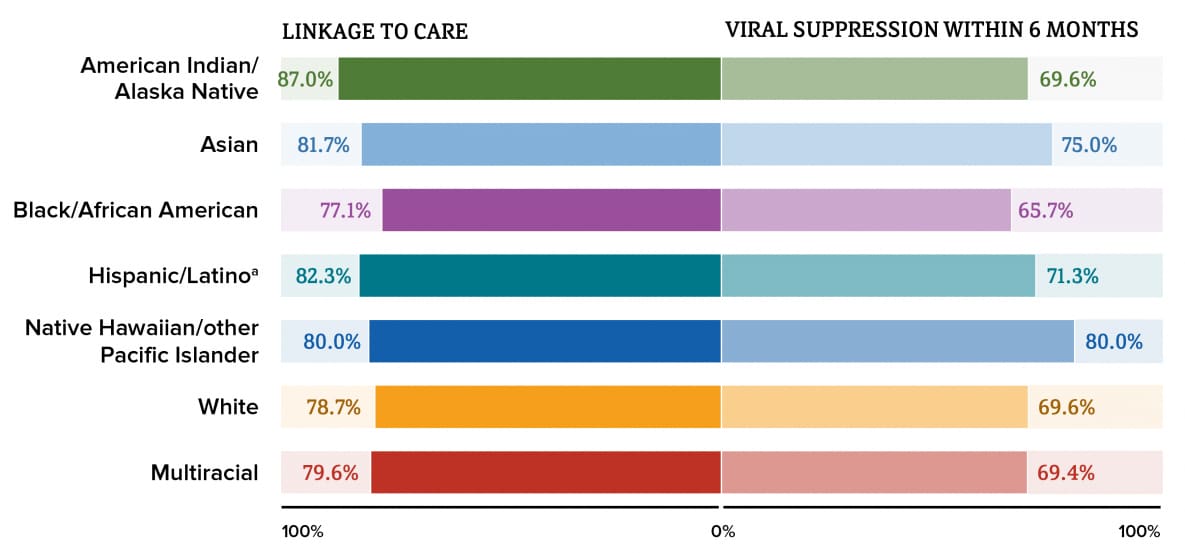
Note. See Guide on Acronyms and Initialisms, Data Tables, and Technical Notes for more information on Definitions and Data Specifications.
aHispanic/Latino persons can be of any race.
The highest percentage for young persons by race/ethnicity who received any HIV medical care was for Asian persons (85.4%) and the lowest percentage was for Native Hawaiian or other Pacific Islander persons (71.0%). The highest percentage for young persons by race/ethnicity who were retained in HIV medical care was for Asian persons (67.9%) and the lowest percentage was for Native Hawaiian or other Pacific Islander persons (54.8%). The highest percentage for young persons by race/ethnicity who were virally suppressed at the most recent viral load test was for Asian persons (79.9%) and the lowest percentage was for Black or African American persons (58.6%) (Table 3c, Figure 42).
Figure 42. Receipt of HIV Medical Care, Retention in HIV Medical Care, and Viral Suppression during 2019, among Young Persons, by Race/Ethnicity—44 States and the District of Columbia
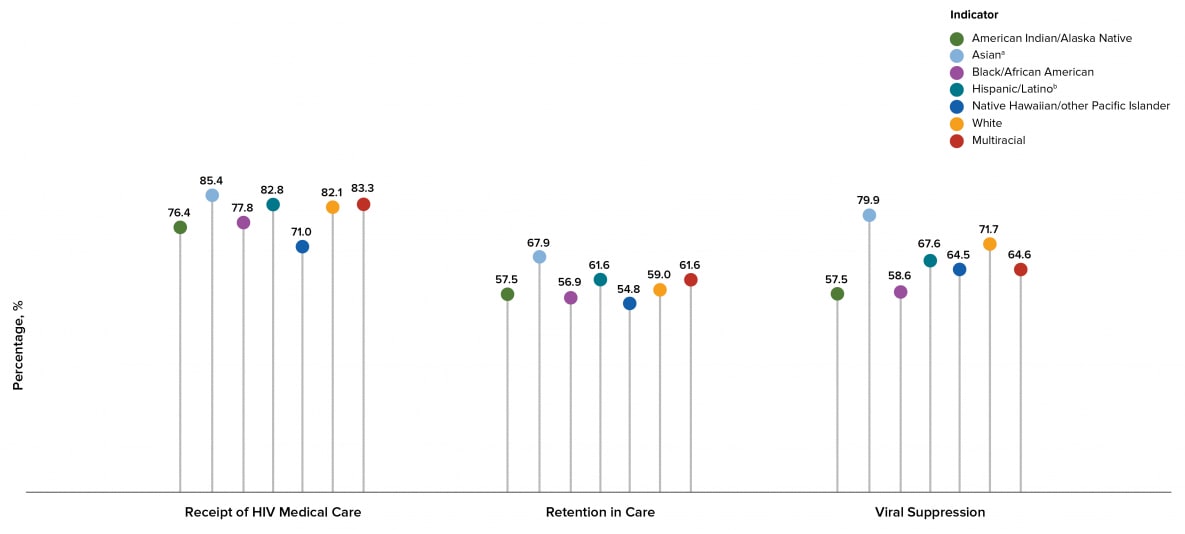
Note. See Guide on Acronyms and Initialisms, Data Tables, and Technical Notes for more information on Definitions and Data Specifications.
aIncludes Asian/Pacific Islander legacy cases.
bHispanic/Latino persons can be of any race.
2019 Status & Disparities in Linkage to Care Within 1 Month of HIV Diagnosis and Viral Suppression
Achieving equitable health in HIV-related outcomes can reduce new HIV infections and eliminate HIV-related disparities in the United States consistent with the goals of Healthy People 2030, NHSP, and the EHE initiative. This section present the current status and HIV-related disparities for two favorable care outcomes, the percentage of persons with newly diagnosed HIV who were linked to care within 1 month of diagnosis and persons living with diagnosed HIV that had viral suppression during 2019, prior to the start of national plans and initiatives.
To assess the status and measure HIV-related disparities for both outcomes, we explored the analytic approach used in Healthy People 2030 [9-12]. We assessed the status of the overall outcomes relative to the proposed national targets of 95% for linkage to care and viral suppression. We measured disparities for the two outcomes by selected characteristics (i.e., race/ethnicity, transmission category, and geographic area) and either chose the 95% outcome target or the group with the highest percentage for each outcome as our reference point. We measured the HIV-related disparities comparing the population groups with the highest and lowest percentage for that outcome to their respective targets and to each other using one absolute (i.e. maximal percentage difference) and/or two relative disparity measures (i.e., maximal percentage ratio and summary percentage ratio) to highlight opportunities for improvement. Maximal or absolute percentage difference is the difference between the group with the highest and lowest percentage for an outcome. Maximal percentage ratio is the ratio between the group with the highest and lowest percentage for an outcome. The summary percentage ratio is the ratio between the average of the percentages of all other groups [excluding the group with the highest percentage] and the group with the highest percentage for an outcome.
2019 Status & Disparities in Linkage to HIV Medical Care Within 1 Month of HIV Diagnosis
Our objective is to increase the percentage of persons linked to HIV medical care within 1 month of HIV diagnosis. In 2019, 81.3% of persons with an HIV diagnosis were linked to HIV medical care within 1 month of diagnosis (Table 2a). Linkage to HIV medical care was 13.7% from the 95% target (absolute percentage difference, 95.0%-81.3%) and 0.856 times the 95% target (81.3/95.0). The 2019 status for linkage to care varied by race/ethnicity, transmission category, and population area of residence (Figure 43).
Figure 43. Status of Linkage to HIV Medical Care within 1 Month of HIV Diagnosis during 2019, among Persons Aged ≥13 Years, by Selected Characteristics—44 States and the District of Columbia
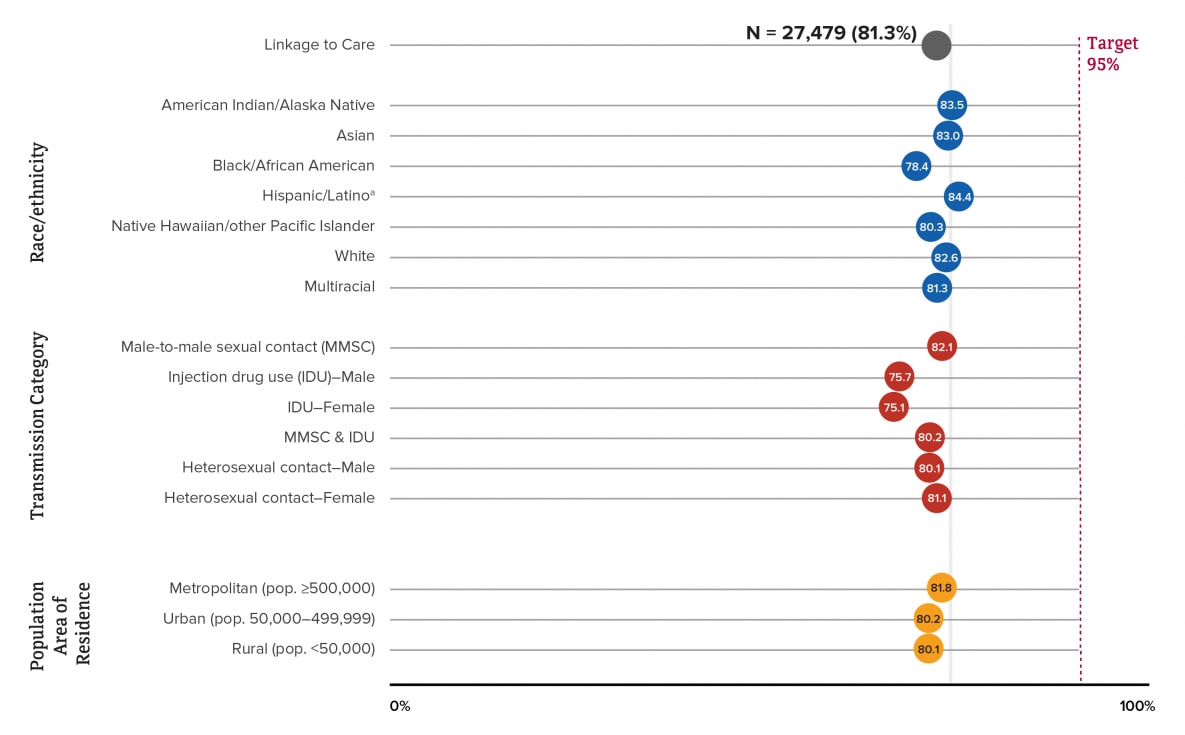
Note. See Guide on Acronyms and Initialisms, Data Tables, and Technical Notes for more information on Definitions and Data Specifications.
aHispanic/Latino persons can be of any race.
By race/ethnicity, the highest linkage to care group percentage was for Hispanic or Latino persons (84.4%) and the lowest linkage to care group percentage was for Black or African American persons (78.4%) (Table 2a, Figure 43). Hispanic or Latino persons (highest linkage to care group) were the closest to the target (absolute percentage difference, 95.0%-84.4%=10.6%) and had a group percentage higher than the overall linkage to care outcome of 81.3%. Black or African American persons were the farthest from the target (absolute percentage difference, 95.0%-78.4%=16.6%) and had a group percentage lower than the overall linkage to care outcome. The percentages for Hispanic or Latino and Black or African American persons were 0.888 and 0.825 times the 95% target respectively ([Hispanic or Latino persons/target]: 84.4/95.0, [Black or African American persons/target]: 78.4/95.0; meeting the target equals 1).
The absolute percentage difference between the percentages for Hispanic or Latino persons (highest linkage to care group, 84.4%) and for Black or African American persons (lowest linkage to care group, 78.4%) was 6.0%. The percentage for Hispanic or Latino persons was 1.077 times the percentage for Black or African American persons (maximal percentage ratio, 84.4/78.4). The average percentage for all other racial/ethnic groups (excluding the percentage for Hispanic or Latino persons) was 81.5%. The absolute percentage difference between the percentage for Hispanic or Latino persons and the average percentage for all other racial/ethnic groups was 2.9% (84.4%-81.5%). The average percentage for all other racial/ethnic groups was 0.966 times the percentage for Hispanic or Latino persons (summary percentage ratio, 81.5/84.4).
By transmission category, the highest linkage to care group percentage was for males with infection attributed to MMSC (82.1%) and the lowest linkage to care group percentage was among females with infection attributed to IDU (75.1%) (Table 2a, Figure 43). Males with infection attributed to MMSC were the closest to the target (absolute percentage difference, 95.0%-82.1%=12.9%) and had a group percentage higher than the overall linkage to care outcome of 81.3%. Females with infection attributed to IDU were the farthest from the target (absolute percentage difference, 95.0%-75.1%=19.9%) and had a group percentage lower than the overall linkage to care outcome. The percentages for males with infection attributed to MMSC and females with infection attributed to IDU were 0.864 and 0.791 times the 95% target respectively ([males with infection attributed to MMSC/target]: 82.1/95.0; [females with infection attributed to IDU/target]: 75.1/95.0).
The absolute percentage difference between the percentages for males with infection attributed to MMSC (highest linkage to care group, 82.1%) and for females with infection attributed to IDU (lowest linkage to care group, 75.1%) was 7.0%. The percentage for males with infection attributed to MMSC was 1.093 times the percentage for females with infection attributed to IDU (maximal percentage ratio, 82.1/75.1). The average percentage for all other transmission categories (excluding the percentage for males with infection attributed to MMSC) was 78.4%. The absolute percentage difference between the percentage for males with infection attributed to MMSC and the average percentage for all other transmission categories was 3.7% (82.1%-78.4%). The average percentage for all other transmission categories was 0.955 times the percentage for males with infection attributed to MMSC (summary percentage ratio, 78.4/82.1).
By population area of residence, linkage to care was similar for all geographic areas (metropolitan: 81.8%, urban: 80.2%, rural: 80.1%). The highest linkage to care group percentage was for persons who resided in metropolitan areas (81.8%) and the lowest linkage to care group percentage was for persons who resided in rural areas (80.1%) (Table 2a, Figure 43). Persons who resided in metropolitan areas were the closest to the target (absolute percentage difference, 95.0%-81.8%=13.2%) and had a group percentage higher than the overall linkage to care outcome of 81.3%. Persons who resided in rural areas were the farthest from the target (absolute percentage difference, 95.0%-80.1%=14.9%) and had a group percentage lower than the overall linkage to care outcome. The percentages for persons who resided in metropolitan areas and in rural areas were 0.861 and 0.843 times the 95% target respectively ([metropolitan/target]: 81.8/95.0, [rural/target]: 80.1/95.0).
The absolute percentage difference between the percentages for persons who resided in metropolitan areas (highest linkage to care group, 81.8%) and for persons who resided in rural areas (lowest linkage to care group, 80.1%) was 1.7%. The percentage for persons who resided in metropolitan areas was 1.021 times the percentage for persons who resided in rural areas (maximal percentage ratio, 81.8/80.1). The average percentage for all other geographic areas (excluding the percentage for persons who resided in metropolitan areas) was 80.2%. The absolute percentage difference between the percentage for persons who resided in metropolitan areas and the average percentage for all other geographic areas was 1.6% (81.8%-80.2%). The average percentage for all other geographic areas was 0.980 times the percentage for persons who resided in metropolitan areas (summary percentage ratio, 80.2/81.8).
2019 Status & Disparities in Viral Suppression
Our objective is to increase the percentage of persons living with diagnosed HIV that were virally suppressed. During 2019, 65.5% of persons living with diagnosed HIV infection at year-end were virally suppressed at the most recent test (Table 4a). Viral suppression was 29.5% from the 95% target (absolute percentage difference, 95.0%-65.5%) and was 0.689 times the 95% target (65.5/95.0). The 2019 status for viral suppression varied by race/ethnicity, transmission category, and population area of residence (Figure 44).
Figure 44. Status of Viral Suppression during 2019, among Persons Aged ≥13 Years Living with Diagnosed HIV Infection, by Selected Characteristics—44 States and the District of Columbia
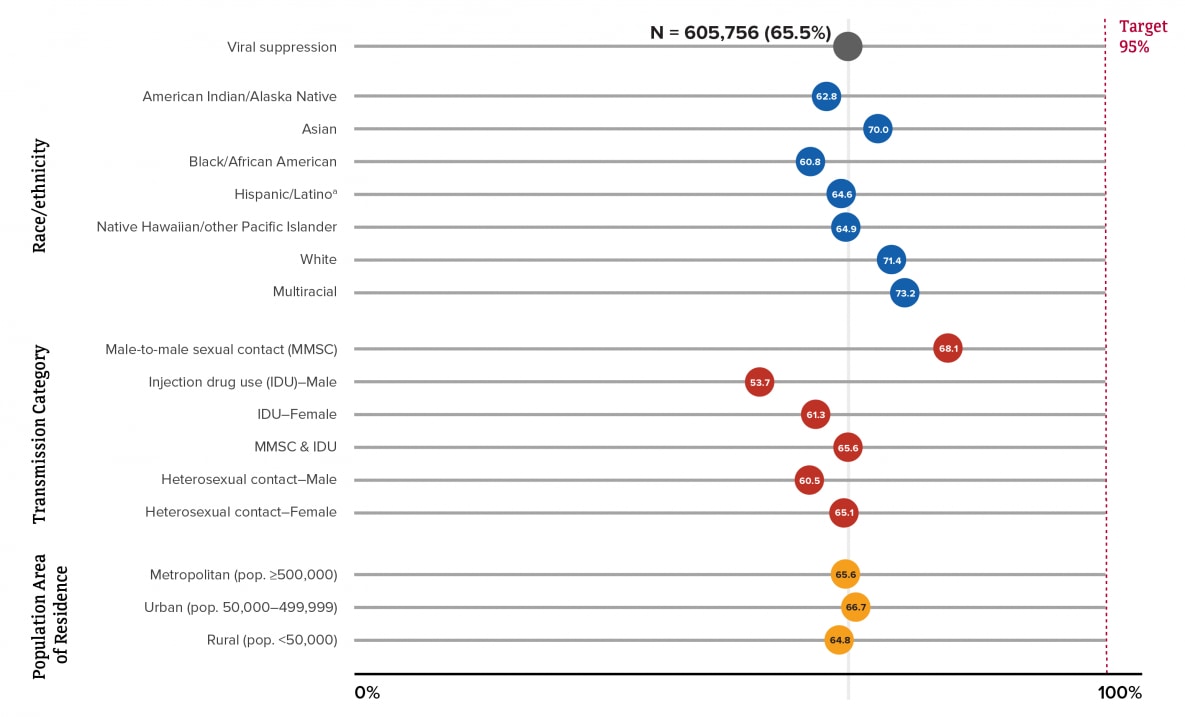
Note. See Guide on Acronyms and Initialisms, Data Tables, and Technical Notes for more information on Definitions and Data Specifications.
aHispanic/Latino persons can be of any race.
By race/ethnicity, the highest viral suppression group percentage was for multiracial persons (73.2%) and the lowest viral suppression group percentage was for Black or African American persons (60.8%) (Table 4a, Figure 44). Multiracial persons were the closest to the target (absolute percentage difference, 95.0%-73.2%=21.8%) and had a group percentage higher than the overall viral suppression outcome of 65.5%. Black or African American persons were the farthest from the target (absolute percentage difference, 95.0%-60.8%=34.2%) and had a group percentage lower than the overall viral suppression outcome. The percentages for multiracial and Black or African American persons were 0.770 and 0.640 times the 95% target respectively ([multiracial persons/target]: 73.2/95.0, [Black or African American persons/target]: 60.8/95.0; meeting the target equals 1).
The absolute percentage difference between the percentages for multiracial persons (highest VS group, 73.2%) and for Black or African American persons (lowest VS group, 60.8%) was 12.4%. The percentage for multiracial persons was 1.204 times the percentage for Black or African American persons (maximal percentage ratio, 73.2/60.8). The average percentage for all other racial/ethnic groups (excluding the percentage for multiracial persons) was 65.8%. The absolute percentage difference between the percentage for multiracial persons and the average percentage for all other racial/ethnic groups was 7.4% (73.2%-65.8%). The average percentage for all other racial/ethnic groups was 0.899 times the percentage for multiracial persons (summary percentage ratio, 65.8/73.2).
By transmission category, the highest viral suppression group percentage was for males with infection attributed to MMSC (68.1%) and the lowest viral suppression group percentage was for males with infection attributed to IDU (53.7%) (Table 4a, Figure 44). Males with infection attributed to MMSC were the closest to the target (absolute percentage difference, 95.0%-68.1%=26.9%) and had a group percentage higher than the overall viral suppression outcome of 65.5%. Males with infection attributed to IDU were the farthest from the target (absolute percentage difference, 95.0%-53.7%=41.3%) and had a group percentage lower than the overall viral suppression outcome. The percentages for males with infection attributed to MMSC and males with infection attributed to IDU were 0.717 and 0.565 times the 95% target respectively ([males with infection attributed to MMSC/target]: 68.1/95.0, [males with infection attributed to IDU/target]: 53.7/95.0).
The absolute percentage difference between the percentages for males with infection attributed to MMSC (highest VS group, 68.1%) and for males with infection attributed to IDU (lowest VS group, 53.7%) was 14.4%. The percentage for males with infection attributed to MMSC was 1.268 times the percentage for males with infection attributed to IDU (maximal percentage ratio, 68.1/53.7). The average percentage for all other transmission categories (excluding the percentage for males with infection attributed to MMSC) was 61.2%. The absolute percentage difference between the percentage for males with infection attributed to MMSC and the average percentage for all other transmission categories was 6.9% (68.1%-61.2%). The average percentage for all other transmission categories was 0.899 times the percentage for males with infection attributed to MMSC (summary percentage ratio, 61.2/68.1).
By population area of residence, viral suppression was similar for all geographic areas (metropolitan: 65.6%, urban: 66.7%, rural: 64.8%). The highest viral suppression group percentage was for persons who resided in urban areas (66.7%) and the lowest viral suppression group percentage was for persons who resided in rural areas (64.8%) (Table 4a, Figure 44). Persons who resided in urban areas were the closest to the target (absolute percentage difference, 95.0%-66.7%=28.3%) and had a group percentage higher than the overall viral suppression outcome of 65.5%. Persons who resided in rural areas were the farthest from the target (absolute percentage difference, 95.0%-64.8%=30.2%) and had a group percentage lower than the overall viral suppression outcome. The percentages for persons who resided in urban areas and in rural areas were 0.702 and 0.682 times the 95% target respectively ([urban/target]: 66.7/95.0; [rural/target]: 64.8/95.0).
The absolute percentage difference between the percentages for persons who resided in urban and rural areas was 1.9% (66.7%-64.8%). The percentage for persons who resided in urban areas was 1.029 times the percentage for persons who resided in rural areas (maximal percentage ratio, 66.7/64.8). The average percentage for all other geographic areas (including the percentage for persons who resided in metropolitan and rural areas and excluding the percentage who resided in urban areas) was 65.2%. The absolute percentage difference between the percentages for persons who resided in urban and all other geographic areas was 1.5% (66.7%-65.2%). The average percentage for all other geographic areas was 0.978 times the percentage for persons who resided in urban areas (summary percentage ratio, 65.2/66.7).